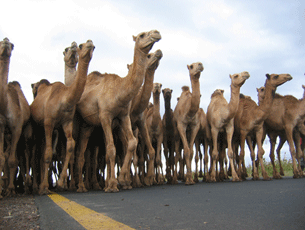|
Tuesday February 08, 2011
Humanitarian Requirements
Humanitarian
Requirements Document 2011(full
download)
07 February, 2011

Humanitarian Requirements Document
Launched
On 7 February 2011, the Humanitarian Requirements Document (HRD),
which requests US$226.5 million for prioritized food and non-food
needs, was launched. A brief summary of the HRD, including key
facts and figures, is attached. For more information, contact:
infodrmfss@dppc.gov.et (PDF
Download)
Food Security Outlook
The latest FEWS-NET/WFP food security outlook indicates that food
security improved in meher (long cycle) crop-producing
parts of the country with the most recent harvest and anticipates
favourable food security conditions between January and June in
most parts of the country. The crop production forecast sample
survey conducted by the Central Statistics Agency (CSA) between
September and October also indicated a good harvest, with
production estimated to be about nine per cent higher than
2009/10. According to various reports, however, the actual harvest
is likely to be lower than anticipated due to yield losses,
primarily in the highlands, as a result of heavy rains which
caused water logging, flooding and hailstorms, as well as pest and
disease infestation, including yellow rust. Despite overall price
stability, staple cereal prices are steadily increasing and
livestock prices declining in the southern and south-eastern
pastoral and agro-pastoral zones due to the poor October to
December 2010 rains. For more information, contact:
ethiopia@fewsnet.net
&
wfp.addisababa@wfp.org
(PDF
Download)
Seasonal Outlook
The
latest forecast issued by the National Meteorology Agency (NMA)
anticipates the continuation of a ‘moderate to strong’ La Niña
phenomenon, potentially through June 2011. The belg/gu
rains are generally anticipated to be below-normal in most
receiving areas. In the eastern, southern and south-eastern parts
of the country belownormal rains are anticipated, while normal
rains are expected over the western and south-western parts of the
country. Overall, erratic onset, near normal cessation and dry
spells are expected during the coming belg season. For more
information, contact:
diadimoswon@yahoo.com
(PDF
Download)
Health Update
The Ethiopian Health and Nutrition Research Institute/Public
Health Emergency Management (EHNRI/PHEM) reported 534 new cases of
measles in SNNP (Gamo Gofa, Gedio, Sidama, South Omo zones as well
as Alaba and Konso special woredas) and Somali (Gode) regions
between 24 and 31 January 2011. The majority of the cases (529
cases) were reported from SNNPR. The case fatality rate (CFR) has
remained below 1 per cent in most reporting areas due to improved
case management activities. According to UNICEF, the majority of
cases reported in 2011 are among children above 5 years of age, as
the 2010 measles standard immunization activities (SIA) targeted
children under 4 years of age. WHO has distributed specimen
collection kit to South Omo zone (SNNPR) to enhance measles
laboratory investigation.
During the same reporting week, nine new cases of acute watery
diarrhoea (AWD) were reported in Jarso woreda, East Hararghe zone
of Oromia Region. The Oromia Regional Water Bureau distributed
water purification chemicals and four AWD kits from its
pre-positioned supplies. The Ministry of Health (MoH) facilitated
an interregional AWD coordination meeting between Oromia and SNNP
regions in Dilla town on 25 and 26 January 2011. The meeting
recommended timely information sharing and cross-regional support
on case management and health education. Some 35 participants from
the MoH, RHBs, zonal health bureaus (Sidama, Gedio and, Borena),
Dilla hospital, IRC and UNICEF attended the meeting.
A rapid response team has been established in Gambella Zuria,
Abobo, Goge, Jore, Etang and Lare woredas in Gambella Region as
part of the RHB’s emergency preparedness and response plan. WHO
has supported the establishment of the team, which includes a
woreda health officer, health facility workers and laboratory
technician. The team is delegated to conduct rapid assessment,
initial response and reporting in the event that a health
emergency arises. For more information, contact:
who-wro@et.afro.who.int
&
kmcdonald@unicef.org
(PDF
Download)
Water Shortage Update
The number of people affected by water shortages is increasing
with the extended dry season. In Oromia Region, the number of
affected woredas has increased from 25 to 33 and corresponding
emergency trucking needs have increased from 31 to 59, with 21
trucks currently deployed. Similarly, two additional water trucks
have been requested in Somali Region (151 trucks currently
required) to address newly-affected woredas. OWDA (with support
from UNICEF and CHF) in Warder, Mercy Corps in Gashamo, IRC in
Aware, Oxfam GB in Harshin, Save the Children UK in Ayisha and Fik
zones and ADRA in Bare are finalizing arrangements to start
emergency water rationing interventions. The Somali Regional Water
Bureau has rehabilitated 24 non-functional boreholes. Meanwhile,
FEWS-NET/WFP latest report indicates that water prices have become
unaffordable, particularly for the poor and very poor, and
increased expenditure on water is likely to create food gaps even
for relatively betteroff households. For more information,
contact:
kmcdonald@unicef.org
&
ethiopia@fewsnet.net
(PDF
Download)
Humanitarian Requirements
Humanitarian Requirements Document,
2010 -
Download Document
Cluster Page(Beta1)
|
|
|
Updated
on 24 January, 2011 |
| |
|

